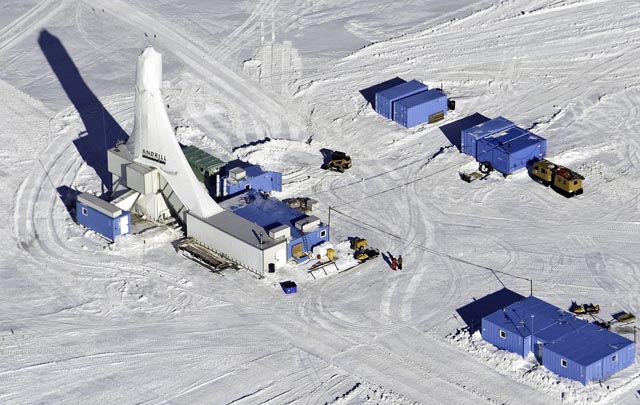Rich layerNew ANDRILL fossil find denotes significant warm period 15.7 million years agoPosted October 24, 2009
Antarctica once enjoyed summer-time temperatures that averaged 10 degrees Celsius — a climate more suited for a warm fleece than a thick parka — about 15.7 million years ago. That’s the conclusion scientists drew from the discovery of a thick layer of fossils from marine algae and the pollen of woody plants in a sediment core drilled into the seafloor of McMurdo Sound in 2007. Researchers with the ANtarctic Geological DRILLing Program (ANDRILL) Sophie Warny “First I thought it was a mistake, that it was a sample from another location, not Antarctica, because of the unusual abundance in microscopic fossil cysts of marine algae called dinoflagellates. But it turned out not to be a mistake, it was just an amazingly rich layer,” Warny said. More on ANDRILL
ANDRILL took two sediment cores near the U.S. Antarctic Program’s McMurdo Station The microscopic fossils were found in unusual abundance in a two-meter-thick layer from the 2007 core of seafloor sediments that measured more than 1,100 meters long. “We all analyzed the new samples and saw a 2,000-fold increase in two species of fossil dinoflagellate cysts, a five-fold increase in freshwater algae and up to an 80-fold increase in terrestrial pollen,” Warny said. “Together, these shifts in the microfossil assemblages represent a relatively short period of time during which Antarctica became abruptly much warmer.” This apparent bloom of life in Antarctica occurred during a generally warm time referred to as the Mid-Miocene Climatic Optimum, according to the scientists. This was a time when global temperatures were warmer than at present. It could serve as an analogue to how the ice sheets of today may respond to warming temperatures in the coming century. “This event will lead to a better understanding of global connections and climate forcing,” said David Harwood ANDRILL scientists say these findings corroborate and expand evidence for lakes and vegetation farther inland in the nearby McMurdo Dry Valleys That research team — headed by David Marchant Earlier this year, ANDRILL scientists published two papers in the journal Nature, including one that suggested even a slight rise in atmospheric concentrations of carbon dioxide, one of the gases that drives global warming, affects the stability of the West Antarctic Ice Sheet (WAIS). The ice sheet contains enough ice to raise sea level by about six meters. The evidence from the 2006 core, nearly 1,300 meters long, traveled back in time to the Pliocene era, roughly 2 million to 5 million years ago. During that era, Antarctica was also warmer than today, and atmospheric carbon dioxide levels were higher. Data from the core indicate the ice sheet advanced and retreated numerous times in response to climate changes. “Geological archives, such as the ANDRILL core, highlight the risk that a significant body of permanent Antarctic ice could be lost within the next century as Earth’s climate continues to warm,” said Tim Naish “Based on ANDRILL data combined with computer models of ice sheet behavior, collapse of the entire WAIS is likely to occur on the order of 1,000 years, but recent studies show that melting has already begun,” said Naish when Nature published the papers in March 2009. NSF-funded research in this story: David Harwood and Richard Levy, University of Nebraska-Lincoln, Award No. 0342484
|



For USAP Participants |
For The Public |
For Researchers and EducatorsContact UsU.S. National Science FoundationOffice of Polar Programs Geosciences Directorate 2415 Eisenhower Avenue, Suite W7100 Alexandria, VA 22314 Sign up for the NSF Office of Polar Programs newsletter and events. Feedback Form |


